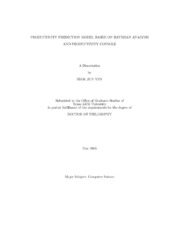| dc.description.abstract | Software project management is one of the most critical activities in modern software
development projects. Without realistic and objective management, the software development
process cannot be managed in an effective way. There are three general
problems in project management: effort estimation is not accurate, actual status is
difficult to understand, and projects are often geographically dispersed. Estimating
software development effort is one of the most challenging problems in project
management. Various attempts have been made to solve the problem; so far, however,
it remains a complex problem. The error rate of a renowned effort estimation
model can be higher than 30% of the actual productivity. Therefore, inaccurate estimation
results in poor planning and defies effective control of time and budgets in
project management. In this research, we have built a productivity prediction model
which uses productivity data from an ongoing project to reevaluate the initial productivity
estimate and provides managers a better productivity estimate for project
management. The actual status of the software project is not easy to understand
due to problems inherent in software project attributes. The project attributes are
dispersed across the various CASE (Computer-Aided Software Engineering) tools and
are difficult to measure because they are not hard material like building blocks. In
this research, we have created a productivity console which incorporates an expert
system to measure project attributes objectively and provides graphical charts to
visualize project status. The productivity console uses project attributes gathered
in KB (Knowledge Base) of PAMPA II (Project Attributes Monitoring and Prediction
Associate) that works with CASE tools and collects project attributes from the
databases of the tools. The productivity console and PAMPA II work on a network, so
geographically dispersed projects can be managed via the Internet without difficulty. | en |


